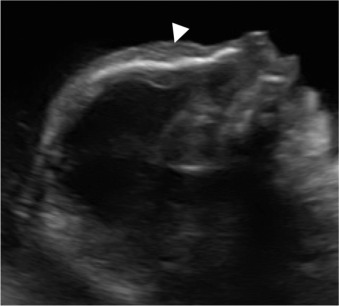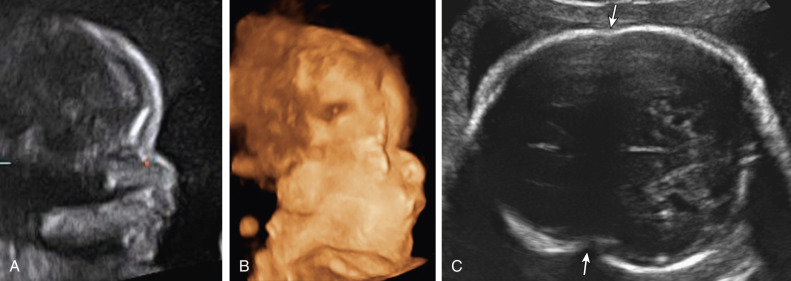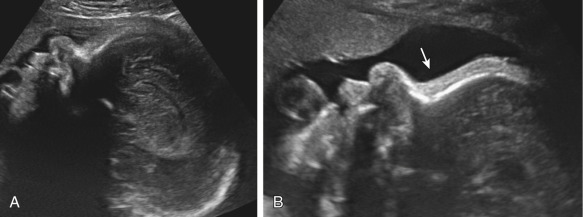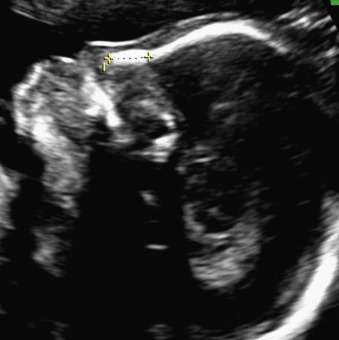Abstract
Facial dysmorphism includes all abnormalities of facial features that are usually associated with syndromic conditions. The objectives of this chapter are first to describe the systematic evaluation of the fetal face using multiplanar evaluation by ultrasound (US), and second to review the anomalies at this level and the conditions related to them. Detection is challenging considering the large phenotypic variability in human face. Thus isolated facial abnormalities must be evaluated, taking into account the facial characteristics of parents. Abnormalities that are included in this chapter are:
- 1.
a sloping forehead that is due to a severe hypoplasia of frontal lobes that occurs in microcephaly;
- 2.
frontal bossing, prominence of the frontal bone due to a premature closure of cranial sutures, which can be found in Apert syndrome, achondroplasia, and thanatophoric dysplasia;
- 3.
hemifacial microsomia, an asymmetric hypoplasia of facial structures (hemifacial microsomia, cleft lip/palate, microphthalmia, external ear anomalies), mainly related to oculoauriculovertebral spectrum, which is a rare condition with poor prognosis including mental retardation and high birth mortality of 20%; and
- 4.
otocephaly, a severe and lethal malformation characterized by an absence or hypoplasia of the mandible, aglossia, proximity of the temporal bones, and abnormal horizontal position of the ears. It can be found isolated or associated with anomalies such as holoprosencephaly, neural tube defects, cephalocele, midline proboscis, tracheoesophageal fistula, cardiac anomalies, and adrenal hypoplasia.
Keywords
fetal profile, frontal bossing, sloping forehead, craniosynostosis, microcephaly, hemifacial microsomia, otocephaly, arhinia, proboscis, bilateral facial cleft, micrognathia, retrognathia
Introduction
Facial dysmorphism is a classical feature of many syndromes, and commonly includes one or a combination of facial features such as low-set ears, hypotelorism or hypertelorism, micrognathia or retrognathia, frontal bossing, and sloping forehead. Considering some of these features are detectable prenatally, facial assessment in routine ultrasound (US) could lead to the diagnosis of chromosomal anomalies or polymalformative syndromes.
Disease
Definition
Facial dysmorphism includes all abnormalities in facial features that are usually associated with syndromic conditions.
Prevalence and Epidemiology
The prevalence and epidemiology of facial dysmorphism is ill defined, since under this common definition there is a wide group of conditions.
Etiology and Pathophysiology
Abnormalities associated with abnormal facial shape are listed in Table 69.1 .
| Microcephaly |
| Apert syndrome |
| Achondroplasia |
| Thanatophoric dysplasia |
| Hemifacial microsomia |
| Otocephaly |
| Proboscis |
| Arhinia |
| Bilateral facial cleft |
| Retro-micrognathia |
Manifestations of Disease
Clinical Presentation
Detection is challenging considering the large phenotypic variability in human faces. Consequently, phenotypic traits of parents could lead to misdiagnosis of abnormalities in otherwise normal fetuses manifesting a parental facial feature ( Fig. 69.1 ). Thus isolated facial abnormalities must be evaluated, taking into account the facial characteristics of parents. Abnormalities that are detectable on the evaluation of the fetal profile can be summarized as follows:
- 1.
Abnormalities in frontal bone:
- (a)
Sloping forehead: this change in frontal bone morphology is due to a severe hypoplasia of frontal lobes that occurs in microcephaly ( Fig. 69.2 ). Once microcephaly is suspected, it is essential to carefully assess brain structures in order to exclude associated brain anomalies. Additionally, an anatomic scan and karyotype should be performed, because microcephaly is strongly associated with structural and chromosomal anomalies.

Fig. 69.2
Fetus with sloping forehead (arrowhead) in a case of encephalocele with microcephaly.
- (b)
Frontal bossing: this is a prominence of frontal bone due to a premature closure of cranial sutures. This condition can be found in Apert syndrome, achondroplasia, and thanatophoric dysplasia. When frontal bossing is found in a routine US, associated anomalies should be ruled out ( Table 69.2 ). Common syndromes with this abnormality are Apert syndrome ( Fig. 69.3 ) , achondroplasia ( Fig. 69.4 ), and thanatophoric dysplasia.
TABLE 69.2
DIFFERENTIAL DIAGNOSIS OF ANOMALIES ASSOCIATED WITH FRONTAL BOSSING
Turricephaly, depressed nasal bridge, brachysyndactyly of hands and feet, craniosynostosis of the coronal suture, fusion of cervical vertebrae, renal anomalies, and heart anomalies
Apert syndrome
Rhizomelia (late-onset), low nasal bridge, macrocrania
Achondroplasia
Severe limb shortening (femurs in particular), lethal thoracic hypoplasia
Thanatophoric dysplasia

Fig. 69.3
Apert syndrome. On the midsagittal view of the facial profile, the frontal bossing and the low nasal bridge are evident in (A) 2D and (B) 3D surface-mode imaging. In 2D axial transthalamic view (C) the closure of the coronal suture (arrows) could be detected.

Fig. 69.4
Achondroplasia in the third trimester. (A) Midsagittal view showing tendency to macrocrania and (B) low nasal bridge (arrow).
- (a)
- 2.
Nose abnormalities:
- (a)
Arhinia: absence of nasal bone and soft tissues.
- (b)
Proboscis: soft tissue appendix that protrudes in the midline from the nasal root area.
- (c)
These abnormalities are highly associated with holoprosencephaly.
- (a)
- 3.
Mouth anomalies: normally included in the cleft lip spectrum (see Chapter 65 ).
- 4.
Chin anomalies: see Chapter 68 .
- 5.
Hemifacial microsomia: an asymmetric hypoplasia of facial structures. It is mainly associated with the diagnosis of oculoauriculovertebral spectrum (OAVS). This is a sporadic condition with an incidence of 1 : 3000 to 1 : 5000 newborns, but autosomal-dominant and recessive modes of inheritance have also been suggested. Estimated recurrence risk is approximately 3%. OAVS is characterized by a variable degree of the underdevelopment of organs originating from the first and second branchial arches. It has been speculated that it is caused by unilateral disruption of blood supply between the fourth and eighth conceptional weeks. Unilateral facial anomalies include hemifacial microsomia, cleft lip/palate, microphthalmia, external ear anomalies (malformed ear, low-set ear, microtia, anotia, and preauricular tag), and vertebral anomalies. Diagnosis can be made by two-dimensional (2D) US, but three-dimensional (3D) surface-mode imaging can help in evaluating hemifacial microsomia and external ear anomalies. OAVS may be associated with anomalies such as congenital heart defects (septal defects), urinary tract defects (hydroureteronephrosis and renal agenesis), central nervous system (CNS) anomalies (agenesis of the corpus callosum and cerebellar abnormalities), and lung malformations (hypoplasia or aplasia). The term Goldenhar syndrome should refer to those cases of OAVS with epibulbar dermoid and vertebral anomalies. Prognosis of OAVS is poor, with a birth mortality of 20%. The risk of mental retardation is related to the high frequency of CNS abnormalities and microphthalmia. Hearing loss may also be present due to the involvement of the external ear. In survivors after birth, cosmetic surgery is indicated.
- 6.
Otocephaly: a severe and lethal malformation with an estimated incidence of one in 70,000 infants. Most cases are sporadic, but some drugs such as theophylline, beclomethasone, and salicylates are reported as associated substances. It is characterized by an absence or hypoplasia of the mandible, aglossia, proximity of the temporal bones, and abnormal horizontal position of the ears. Embryologically, this lethal malformation is thought to be the result of failure of mandibular development, possibly secondary to a defect in neural crest cell migration. Otocephaly should be suspected when it is impossible to identify the jaw and the ears in their normal position ( Fig. 69.5 ; ). Three-dimensional surface-mode imaging could be very useful to improve the accuracy of the diagnosis, since occasionally the anomaly is not clearly seen by 2D ultrasonography. Otocephaly can be isolated, or associated with anomalies such as holoprosencephaly, neural tube defects, cephalocele, midline proboscis, tracheoesophageal fistula, cardiac anomalies, and adrenal hypoplasia. No gene or chromosome aberrations are clearly associated with otocephaly. The prognosis is very poor.

Fig. 69.5
Otocephaly. (A) Midsagittal view showing the absence of jaw. (B) Axial plane showing the impossibility to identify ears in their normal position. (C) Fetus after termination of pregnancy.


Stay updated, free articles. Join our Telegram channel

Full access? Get Clinical Tree








